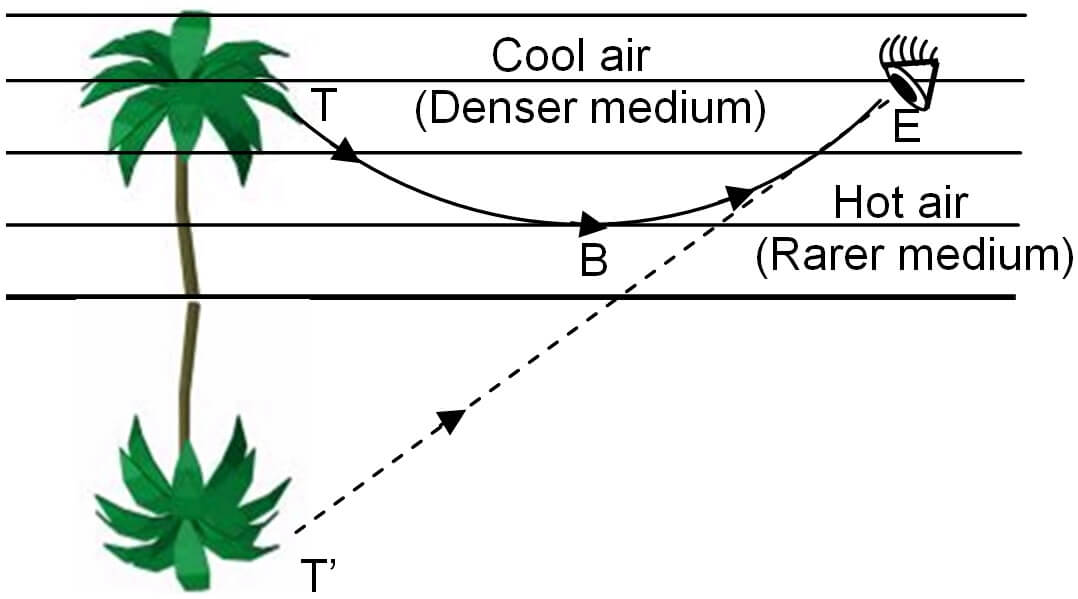The atmosphere of earth consists of different layers of air. Out of these some air layers are hot which have low densities, while the others are cold which have high densities. The hot layers of air behave as optically rarer medium for light rays, whereas the cold layers of air behave as optically denser medium for light rays. So, when an object emits light rays in the atmosphere, these light rays pass through the atmosphere having different air layers of different densities and get refracted by atmosphere. So, the refraction of light caused by the atmosphere of earth is called atmospheric refraction.
We will now discuss in detail some optical phenomenons which take place in nature due to the atmospheric refraction and total internal reflection of light.
Twinkling of Stars
The light rays coming from a star reaches our eyes after passing through the atmosphere having different air layers of different optical densities. But the optical densities of different layers of air keep on changing continuously due to change in temperature conditions. Due to which, the light rays coming from a star are refracted to different amount at different moments of time, and the path of refracted rays keep on changing. As a result, sometimes more light is refracted towards our eyes and the star appears bright to us, whereas sometimes less light is refracted towards our eyes and the star appears dim to us. This gives rise to the twinkling effect of a star.

The Sun is visible to us 2 minutes before actual sunrise and 2 minutes after the actual sunset
The Sun is visible to us 2 minutes before actual sunrise and 2 minutes after the actual sunset due to atmospheric refraction. Actually when the Sun is slightly below the horizon, then the light rays emitted by the Sun are refracted downwards when passing through the optically rarer air layers into the optically dense air layers of atmosphere. Due to which, the Sun appears to be slightly raised above the horizon and is visible 2 minutes before actual sunrise and 2 minutes after the actual sunset.

Mirage
Mirage is an optical illusion which occurs usually in deserts on hot summer days due to atmospheric refraction and total internal reflection of light rays. In mirage, the object such as a tree appears to be inverted as if it is situated on a bank of a pond of water. Actually on a hot summer day, the layers of air near the surface of earth become very hot and hence behave as optically rarer medium. On the other hand, the upper layers of air are comparatively cool and hence behave as optically denser medium. Now, a ray of light from the point T of a tree goes from denser to rarer medium along the path TB and bends away from the normal, at every layer due to atmospheric refraction. But at a particular layer, when the angle of incidence becomes greater than the critical angle, the total internal refraction occurs, and the totally reflected ray travels along the path BE and reaches the observer. Since, we can see the light rays only in straight line path, so the reflected ray BE appears to be coming from the point T’ to the observer. Due to this, an inverted image of the tree is formed below its actual position. And this inverted image of the tree creates the impression as if the reflection of tree is taking place from a pond full of water.


Looming
Looming is also an optical illusion which occurs usually in very cold regions. In looming, a distant object such as a ship moving in polar areas appears to be hanging in midair due to atmospheric refraction and the total internal reflection of light rays.


In Polar Regions the layers of air near the surface of earth are very cold and hence behave as optically denser medium. Whereas, the upper layers of air are comparatively warm and hence behave as optically rarer medium. Now, a ray of light coming from point S of ship goes from denser to rarer medium along the path SB and bends away from the normal, at every layer due to atmospheric refraction. But, at a particular layer, when the angle of incidence becomes greater than the critical angle, the total internal reflection occurs, and the totally reflected ray travels along the path BE and reaches the observer. As we have already discussed that we can see the light only in straight line path, so the reflected ray BE appears to be coming from the point S’ to the observer. Due to this, the observer sees a virtual and erect image of the ship at position S’, which is much above the actual position of the ship in the sea.
Brilliance of diamond
The brilliance of a diamond is due to the total internal reflection of light. We know that the refractive index of diamond is 2.42, and the critical angle for diamond is 240. The diamond is cut in such a way so that the light which enters the diamond from any face suffers multiple total internal reflections at the various faces before coming out of the diamond. Due to this, the diamond sparkles.

Test Your Understanding and Answer These Questions:
- What is atmospheric refraction?
- Give an application of the process of total internal refraction.
- Why do stars twinkle at night?
- Explain why the Sun is visible to us 2 minutes before actual sunrise and 2 minutes after the actual sunset?
- Define mirage? Explain mirage in hot areas with the help of a diagram.
- What is looming? Explain looming with the help of a diagram.
- What is the reason of brilliance of diamond?
